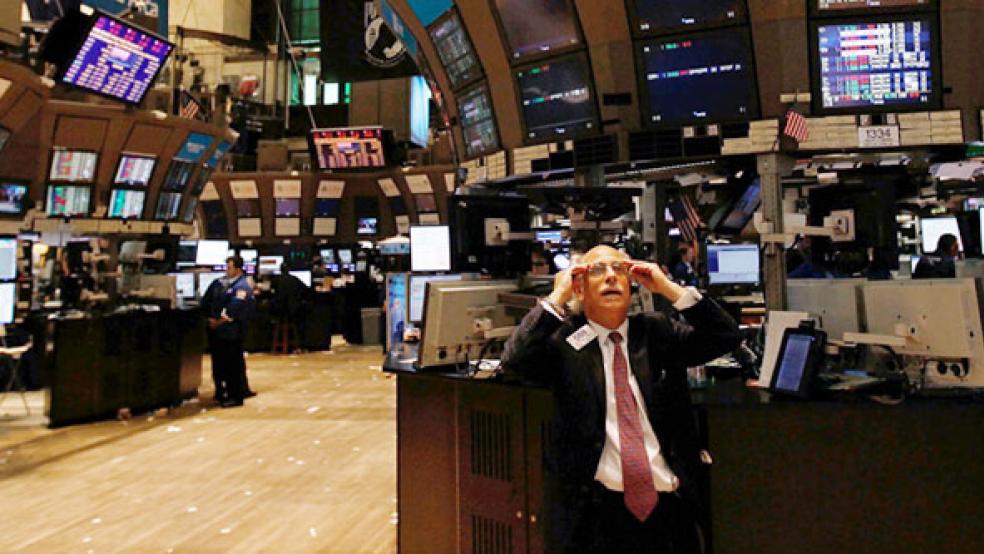As nerve-wracking as Monday’s stock-market volatility was for investors, market pros say Standard & Poor’s warning about U.S. debt could ultimately be good news for financial markets. Their logic: If S&P’s move leads to real efforts to rein in the U.S.’s massive federal deficit, the markets will benefit.
After Standard & Poor’s ratings service lowered its outlook on U.S. government debt to “negative” from “stable,” and signaled it might lower the country’s pristine triple-A credit rating within two years, the Dow Jones Industrial Average plunged more than 200 points, then gained a bit to close down 140. On Tuesday, stocks recovered somewhat, with the Dow up about 65 points, and prices of long-term Treasurys rose, sending yields lower. But gold, considered a haven in uncertain times, rose to a record high of $1,500 an ounce, before retreating slightly.
“In case anyone thought America’s massive deficit did not have implications for investors,” Karthik Ramanathan, director of institutional portfolio management, fixed income, at Fidelity Management & Research wrote in a report. “The stock market drop in the wake of S&P’s decision…might give them pause.”
But most market experts said they weren’t surprised by the S&P’s move. Bill Gross, co-chief investment officer of bond-investing powerhouse PIMCO, has been very vocal in recent months about his antipathy toward U.S. government debt and recently unloaded the firm’s Treasury holdings. Gross predicted more than two years ago that the U.S. could lose its AAA debt ratings, and told on Monday that he thought S&P had been slow to act. “They move very cautiously and very slowly,” he said. “That doesn’t mean that the United States’ credit rating hasn’t been going downhill for the past few years, because it has.”
So where is the good news for investors? Granted, it’s in the interest of top executives at investment firms to be optimistic about investment opportunities. But here’s their argument: S&P’s announcement isn’t terribly significant in itself, since the agency didn’t actually change its rating of U.S. debt, but it increases the urgency to find a solution to the country’s fiscal crisis. “It’s not a big surprise, but it’s one more signal that something needs to be done,” says Jonathan Lemco, senior credit analyst at Vanguard Group. “It’s a wake-up call and that’s a good thing.”
The U.S. is likely to reach the debt limit of $14.3 trillion within weeks, and an increase requires a vote by a divided Congress. “While a U.S. default is unlikely,” wrote Fidelity’s Ramanathan, “the heightened attention to fiscal matters could ultimately lead to some much-needed longer term reforms.” Long-term reforms, he argues, will lead to long-term stability in financial markets.
In the short-term, however, investors might want to brace themselves. If there is a pitched battle over raising the debt ceiling or if political brinksmanship drags out a solution, financial markets may grow more volatile over the next few months. Despite signs that corporate profits are improving and economic growth is slowly returning, Monday’s news shows how deficit concerns can roil markets. And the longer Congress takes to vote on increasing the debt ceiling, the more nervous foreign creditors are likely to become regarding the Treasury’s ability to service its debt, according to Ramanathan. They may reduce their U.S. debt holdings, causing interest rates to rise, and the U.S. dollar may fall in value vs. other currencies. The euro rose against the dollar Tuesday.
While he doesn’t expect the U.S. to default on its debt, Eric Jacobson, Morningstar’s director of fixed-income research said in an interview posted on the fund company’s website, the bigger problem may be inflation generated by the production of more currency. “People like to say we have our own printing press, that we have the capacity to print more dollars, absorb more debt, and essentially cause inflation,” he said. “Inflation actually lowers the cost of the United States.”
Jacobson says he probably wouldn’t act specifically on the S&P news that came out Monday, but it was a signal to investors about what’s driving financial markets. He points out that yields on Treasury bonds currently aren’t very high – less than 3.4 percent on a 10-year note. “Put it in the way that big-time managers like Bill Gross and TCW/MetWest and others think about it: You’re just not getting paid enough to take on those risks even if you aren’t worried about the U.S. defaulting.”
Related Links:
S&P Threatens to Cut U.S. Debt Rating (Yahoo News)
How to Invest on the S&P Downgrade of U.S. Debt (TheStreet.com)




